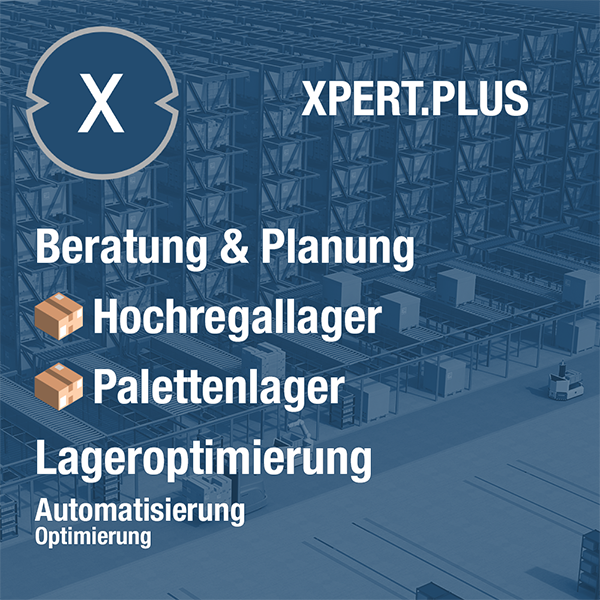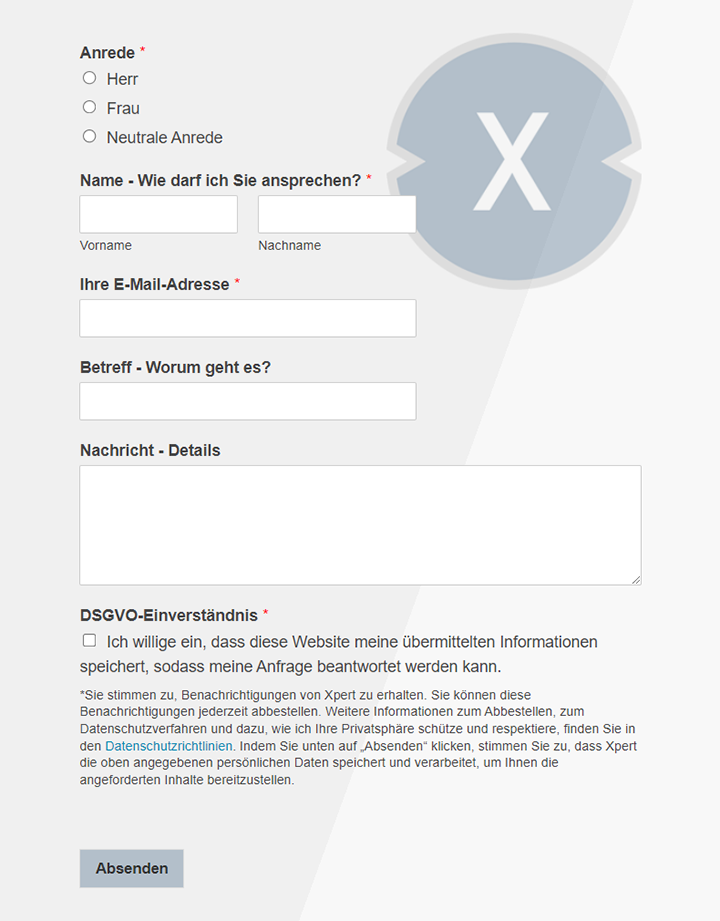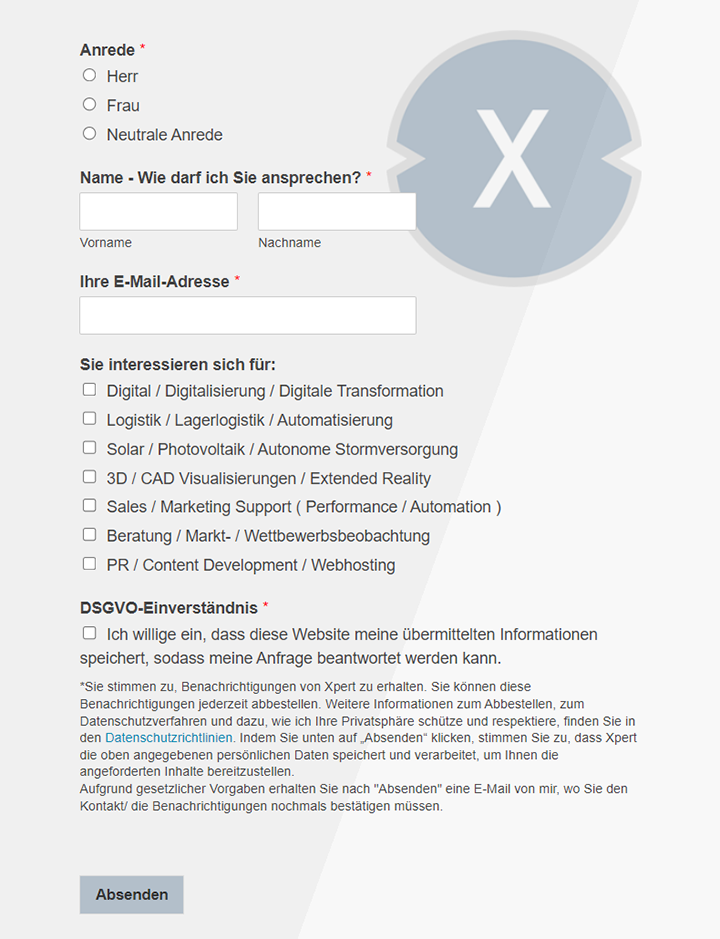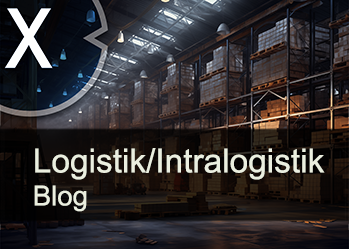Optimization strategies of the storage capacity of the future: transformation through vertical growth and smart systems
Xpert pre-release
Language selection 📢
Published on: February 23, 2025 / update from: February 23, 2025 - Author: Konrad Wolfenstein

Optimization strategies of the storage capacity of the future: Transformation through vertical growth and smart systems - Image: Xpert.digital
Why optimized storage capacities decide the competition
The importance of storage capacity in modern logistics: expansion, optimization and innovative technologies
In today's dynamic economic world, which is characterized by globalized markets, accelerated supply chains and increasing customer expectations, the storage capacity has a decisive importance for the success of companies of all industries. The ability to store, manage and distribute efficiently and effectively is no longer just a supporting function, but a strategic competitive advantage. Companies that invest in the expansion and optimization of their storage capacities lay the foundation for operational excellence, improved customer satisfaction and sustainable growth.
We are currently observing a significant trend in the logistics industry to expand and optimize the capacity of camps. This trend is powered by a variety of factors, including the exponential growth of e-commerce, the increasing complexity of the global supply chains, the need to ensure just-in-time deliveries, and the constant pressure to reduce costs and the efficiency to increase. Companies are increasingly realizing that insufficient storage capacity can lead to bottlenecks, delays, higher costs and ultimately dissatisfied customers. To meet these challenges, they massively invest in the expansion of their warehouse infrastructure and the implementation of innovative technologies and strategies for capacity optimization.
Suitable for:
Strategies for expanding capacity: vertical growth and innovative warehouse systems
One of the central strategies for expanding capacity is vertical growth. In urban centers and regions with limited space availability, high -bay warehouse is the ideal solution to optimally use the existing floor surface. These impressive constructions often extend up to a height of 50 meters and beyond and enable the storage of several hundred thousand pallet spaces in relatively small space. Modern high -bay warehouses not only ensure safe storage of goods to high heights - today secure bearings over 45 meters are common practice - but also optimize the logistics processes through fast and direct access to individual loading units. The high storage density in combination with automated input and outsourcing systems leads to maximum space use with low operating costs per storage unit.
The development of high -bay bearings has made enormous progress in recent decades. Early systems were often operated manually and relatively slowly. Today, modern high -bay warehouse is highly automated and integrate complex conveyor technology, shelf control units and warehouse management software (LVS). This automation not only enables a significant increase in the envelope speed and the storage density, but also a reduction in errors and an improvement in occupational safety. In addition, advanced control systems enable precise monitoring and control of all warehouse processes in real time, which contributes to further optimization of efficiency.
In addition to classic high -bay bearings, innovative warehouse systems are becoming increasingly important. These systems are often tailored to specific requirements and offer solutions for special challenges in warehouse logistics. These include:
Pallet shuttle systems
These systems enable particularly compacted storage of pallets by inserting an autonomous shuttle vehicle into the warehouse channel that the pallets independently outsourced and outsourced. Pallet Shuttle systems are ideal for storing large quantities of the same item (LIFO-Last-in-First-Out or FIFO-First-in-First-Out Principles can be implemented depending on the execution) and maximize space use in particular. They reduce the need for accompanying passengers within the shelf system and enable efficient use of the entire storage area. The automation of the input and outsourcing process through the shuttle vehicle leads to a higher envelope speed and a reduction in labor costs.
Canal bearing
Similar to the Pallet Shuttle Systems, canal bearings aim at maximum use of space due to compressed storage. In canal bearings, the loading units in bearing channels are stacked in a row. The storage and outsourcing is usually carried out with special forklifts or shelf operations devices that can drive into the channels. Canal bearings are particularly suitable for storing seasonal articles or articles with a low coverage of the envelope, in which high storage density is more important than quick access to individual articles. They offer an inexpensive solution for capacity expansion, especially in environments in which the property prices are high.
Automated systems with robotized means
The integration of robotics into storage systems represents another important innovation driver. In higher shelving systems, both for pallets and small parts warehouse, robots for picking, storage and outsourcing tasks are increasingly used. These robots can take on a variety of tasks, from simple transport tasks to complex picking processes. They work precisely, quickly and reliably, often around the clock, and thus contribute to a significant increase in efficiency and productivity in the warehouse. Modern robots are equipped with advanced sensor and control systems that enable them to move safely and efficiently in dynamic storage environments and to work with people. The development of collaborative robots (cobots), which can safely work aside with human employees, opens up new opportunities for the automation of warehouse processes.
Optimization of existing warehouse: warehouse sealing, shelf stages and efficient shelf systems
A new building or extensive expansion of the warehouse is not always required to increase capacity. Often the capacity of existing warehouse can be significantly increased by targeted optimization measures. As a rule, these measures are cheaper and faster to implement than new construction projects and can still achieve considerable efficiency gains. The most important optimization strategies include:
Warehouse seal
With an intelligent storage compression, companies can accommodate more loading units on the same area. This is usually achieved by reducing the work and an optimized arrangement of the shelf systems. For example, the use of narrow -passed shelf systems in combination with drawers or picking forklifts can reduce the number of passengers and thus create more storage space. The conversion of block storage to shelf storage or the use of shelving systems with a higher storage density, such as the entry shelves or passage shelves, can also contribute to storing storage. A careful analysis of the warehouse processes and the article structure is crucial to determine the optimal compression strategy and not to impair efficiency.
Shelf
The installation of shelf stages is an effective method to create additional levels within a warehouse and to improve the vertical space use. Shelf stages are essentially intermediate floors that are collected via the existing storage area. They can be used as an additional storage area or as a work surface for picking or packaging work. Regal stages are available in different versions, from simple steel structures to complex multi -storey systems. They are a relatively inexpensive way to expand the storage capacity without changing the existing building envelope. The integration of conveyor technology, such as elevators or conveyor belts, can optimize the flow of goods between the levels.
Efficient shelf systems
The selection of the right shelf system is crucial for optimal use of space and efficient warehouse processes. There are a variety of shelf systems, each of which is suitable for certain product types and storage management methods. The adaptation of the shelf systems to the specific requirements of the company can lead to a significant increase in storage capacity and efficiency. For example, specialist floor shelves can be used for storing small parts, pallet shelves for the storage of pallet goods, cantileverons for the storage of long -goods or throughput shelves for the storage of items with high envelope. The consideration of factors such as article size, weight, envelope frequency, storage principle (FIFO/LIFO) and picking method is crucial for the selection of the optimal shelf system.
Specialized solutions for special requirements
The need for capacity expansion affects not only general goods, but also specialized areas with special requirements for storage. These areas often require tailor -made solutions that are tailored to the specific properties of the stored products and the respective industry standards. Some examples of specialized warehouse solutions are:
Frozen products
The storage of frozen products places extreme demands on the stable frastructure. Frozen bearings must be able to maintain extremely low temperatures, often up to -30 ° C or even deeper. This requires special insulation, cooling technology and energy -efficient systems to minimize operating costs and ensure product quality. In addition to the extreme temperatures, frozen bearing must also meet strict hygiene regulations in order to ensure food safety. Automation plays a particularly important role in freezer because it minimizes the stay of personnel in the cold areas and increases efficiency.
Suitable for:
- From buffer storage for fresh logistics and refrigerated logistics warehouses to automated AI high-bay warehouses and pallet warehouses
- The secrets behind Japan's refrigerated logistics success: Smart, fresh and sustainable right to the door - how high-tech drives refrigerated logistics
Beverage industry
The beverage industry has specific requirements for storage due to the large quantities, the high weight and the often seasonal demand for drinks. Warehouse systems for the beverage industry must be robust, efficient and flexible in order to cope with the high envelope volumes and the different forms of packaging. Block storage is widespread in the beverage industry because it enables a high storage density. However, automated high -bay warehouse with special gripping systems for beverage crates and pallets also gain in importance in order to increase efficiency and optimize the picking processes.
Automotive parts
The automotive industry is known for its complex supply chains and the need for just-in-time deliveries. Warehouse for automotive parts must be able to store a large variety of parts in different sizes and quantities and to deliver them to the production lines on time. Sequence storage, in which the parts are delivered to the production line in the order of assembly, is common in the automotive industry. Automated storage systems, such as small parts warehouse and container production technology, play an important role in the efficient storage and provision of automotive parts.
Medical products and pharmaceuticals
The storage of medical products and pharmaceuticals is subject to strict regulatory requirements and requires special storage systems and processes to ensure product quality, safety and traceability. Temperature -controlled storage areas, clean rooms and safety precautions are standard in pharmaceutical logistics. Compliance with good distribution practices (GdP) and other relevant regulations is of crucial importance. Automated storage systems with comprehensive documentation and traceability support companies in compliance with these strict requirements.
Xpert partner in warehouse planning and construction
Digitization transforms warehouse processes: This is how companies save costs
Automation and digitization as a key to warehouse optimization
A central trend in modern warehouse logistics is increasing automation and digitization. Companies recognize that the use of automation technologies and digital solutions not only optimizes storage capacity, but also increases efficiency, lowers costs and reduces the error rate.
The fully automatic storage and outsourcing of large-scale charging carriers is already a reality in many modern camps. Shelf control units, driverless transport systems (FTS) and robots take on repetitive tasks and enable continuous material flow without manual interventions. This automation leads to a significant increase in the envelope speed, better use of space and a reduction in labor costs.
Intelligent warehouse management systems (LVS)
are the brain of the modern warehouse. They coordinate all warehouse processes, from the input control to storage management and picking to the outcome of the goods. Modern LVs offer a variety of functions to optimize space use, process control and inventory management. They enable real -time transparency across all inventory and movements and support companies in decision -making and planning. The integration of LVS with other company systems, such as Enterprise Resource Planning (ERP) and Transport Management Systems (TMS), enables a continuous digital supply chain and optimizes the entire logistics chain.
The influence of storage capacity on delivery times, efficiency and flexibility
The storage capacity has a direct and significant influence on the logistics and delivery times of a company. An optimally dimensioned and efficient warehouse capacity is crucial for the ability to fulfill customer orders quickly and reliably. Inadequate storage capacity, on the other hand, can lead to bottlenecks, delays and longer delivery times, which has a negative impact on customer satisfaction and company success.
Influence on delivery times
Enables an appropriate storage capacity:
Shorter periods between ordering and shipping order
With sufficient storage capacity, companies can process and send orders faster. The goods are already available in the warehouse and do not have to be procured or produced. This significantly shortens the throughput time from the order intake to delivery.
Faster sorting, picking and provision of programs
Efficient warehouse processes made possible by optimized storage capacity accelerate the sorting, picking and provision of programs. Automated systems and optimized warehouse routes help to minimize travel times and increase the picking speed.
Efficient handling of urgent programs for express transports
Companies with sufficient storage capacity are better able to react to short-term customer requirements and efficiently use urgency or express transport. The goods are quickly available and can be prepared for shipping immediately.
Through optimized storage capacities, companies can react more flexibly to customer requests and adhere to delivery dates more reliably. This leads to higher customer satisfaction, stronger customer loyalty and a competitive advantage. In today's fast -moving business world, in which customers expect shorter delivery times, efficient warehouse logistics with sufficient capacity is a decisive success factor.
Efficiency and cost optimization
A well -dimensioned storage capacity not only leads to shorter delivery times, but also to an optimized operating cost structure and improved usage of space. Efficient warehouse logistics enables companies to reduce costs and increase their competitiveness.
Optimized operating cost structure
Efficient storage capacity contributes to optimizing the operating cost structure. Through better use of space, automated processes and a reduced error rate, companies can reduce costs in various areas, such as rental costs, personnel costs, energy costs and storage costs.
Improved usage of space and minimization of open spaces
An optimized storage capacity maximizes space use and minimizes open spaces in the warehouse. By using high -bay bearings, warehouse densification techniques and efficient shelf systems, companies can store more goods on the same area and reduce the storage costs per warehouse.
Efficient route planning for deliveries
A well -organized storage capacity supports efficient route planning for deliveries. With optimized storage management and picking processes, shipments can be put together faster and provided for shipping. This enables more efficient route planning and reducing transport costs.
These factors contribute to the fact that companies can make their logistics processes cost -effective without having to cut back at the delivery speed. Efficient warehouse logistics is therefore an important contribution to the company's profitability and competitiveness.
Flexibility in the case of demand for demand
An adapted storage capacity enables companies to react more flexibly to fluctuations in demand, be it seasonal fluctuations or unforeseen demand. A sufficient storage capacity offers a buffer to be able to ensure short delivery times even in high -phases and avoid bottlenecks.
Better coping of seasonal or unforeseen demand for demand
Companies with sufficient storage capacity can better manage seasonal demands, such as in the Christmas business or at seasonal products. You can build stocks in good time and operate the increased demand without delays. Unforeseen demand tips, e.g. due to marketing campaigns or sudden market trends, can also be better absorbed.
Faster response to short -term delays or personnel failures
A flexible storage capacity enables a faster reaction to short -term disorders in the operating process, such as delays in deliveries or personnel failures. A sufficient inventory can help to avoid production failures or delivery delays and to ensure the continuity of the company.
Increased flexibility in operational operation
An adapted storage capacity increases the flexibility in operational operation as a whole. Companies can react faster to changes in the market environment, introduce new products or adjust their product range without being restricted by storage bottlenecks.
This flexibility is crucial in order to be able to ensure short delivery times even in high phases and maintain customer satisfaction. In a volatile economy in which markets and customer needs can change quickly, flexible warehouse logistics is an important competitive advantage.
Optimization of warehouse logistics for maximum capacity use
In order to optimally use the storage capacity and to shorten delivery times, companies rely on various strategies to optimize warehouse logistics. These strategies aim to improve the processes in the warehouse, to minimize travel times and to increase the efficiency of employees and the technologies used.
Efficient picking techniques and way optimization (routing)
The picking is one of the most time -consuming processes in the warehouse. Efficient picking techniques such as pick-by-voice, pick-by-light or pick-by vision, can significantly improve the picking speed and accuracy. The way optimization (routing) aims to minimize the moving times of the pickers in the warehouse and to calculate the most efficient routes. Modern LVS support path optimization through dynamic route planning and the consideration of real -time data, such as current inventory and order structures.
Strategic division of the warehouse into product areas (zoning)
The strategic division of the warehouse into product areas (zoning) can shorten the picking trails and increase efficiency. By grouping articles with a similar frequency of envelope or article groups that are often ordered together, the pickers can optimize their paths and reduce the picking times. The zone formation should be based on a detailed analysis of the article structure and the order data.
Use of Warehouse Management Systems (WMS) for digitization and process optimization
The use of Warehouse Management Systems (WMS) is a decisive factor for optimizing warehouse logistics. Digitize and automate the WMS many warehouse processes, from incoming goods to the goods output. They enable real-time portfolio tracking, optimized storage management, efficient picking and detailed process monitoring. Modern WMS also offer functions for the analysis of warehouse data and to identify potential for improvement. The integration of WMS with other company systems, such as ERP and TMS, enables a continuous digital supply chain and optimizes the entire logistics chain.
These measures contribute to the fact that the existing storage capacity is used as best as possible and were quickly found their way to the customer. Optimized warehouse logistics is therefore an essential part of an efficient and competitive supply chain.
Innovative technologies to further optimize the storage capacity
The rapid technological development is constantly offering new opportunities to further optimize their storage capacity and efficiency. Several innovative technologies help to revolutionize warehouse logistics and to set new standards in terms of speed, accuracy and flexibility.
Artificial intelligence (AI) and machine learning (ML)
AI algorithms and machine learning play an increasingly important role in warehouse logistics. AI systems can analyze warehouse data to predict demand, optimize inventory management and plan routes. Machine learning enables systems to improve continuously and to adapt to unforeseen events faster. For example, AI can be used for dynamic storage position optimization, in which the storage spaces are adapted to the current demand and the article structure in real time. In picking, AI-based systems can also optimize the picking trails and support the pickers in selecting the article.
Internet of Things (IoT)
The Internet of Things (IoT) enables the networking of devices, sensors and systems in the warehouse. IoT sensors record real-time data on stocks, temperature, humidity, location of devices and other relevant parameters. This data is used to continuously monitor and adapt the warehouse operation and to ensure precise inventory control. IoT sensors can be integrated in shelves, forklifts, containers and packaging, for example, to enable comprehensive data acquisition. The analysis of the IoT data enables companies to gain insights into their warehouse processes in real time, to recognize bottlenecks and to identify optimization potential. The predictive maintenance of warehouse technology, i.e. the forward -looking maintenance based on sensor data, is also made possible by IoT.
RFID and barcode technology
RFID tags (radio frequency identification) and barcodes enable precise persecution and identification of products in the warehouse. These technologies improve inventory management and facilitate the traceability of goods. RFID tags offer the advantage over barcodes that they can be read out without contact and have a greater reach. This enables faster and more efficient data acquisition, especially with large quantities of articles. RFID technology is increasingly being used in warehouse logistics to capture goods and outputs, carry out inventory inventories and to accelerate picking processes.
Automated systems: Autonomous robot and driverless transport systems (AGS)
Autonomous robots, driverless transport systems (AGVS) and automated forklifts optimize the goods movement and the material flow in the warehouse. These systems increase efficiency and reduce manual work. Transporting AGVs were autonomous within the warehouse without human drivers being necessary. Autonomous robots can be used for picking tasks, sorting tasks and other repetitive activities. Automated forklifts take over the transport of pallets and other large load carriers. The use of these automated systems leads to a significant increase in the envelope speed, a reduction in the error rate and an improvement in occupational safety.
Warehouse management software (LVS) of the next generation
LVS of the next generation coordinate the various processes in the warehouse and synchronize the tasks of employees and machines. They enable inventory control in real time and can be integrated with other systems such as ERP (Enterprise Resource Planning), TMS (Transport Management System) and MES (Manufacturing Execution System). Modern LVs offer extended functions such as dynamic storage position optimization, AI-based process control, mobile applications for employees and cloud-based solutions. They enable comprehensive digitization and automation of warehouse logistics and contribute to a significant increase in efficiency and transparency.
Wearable technology: data glasses and intelligent bracelets
AR glasses (augmented reality) or intelligent bracelets give employees real-time information on products, orders and locations. This facilitates picking and other tasks. Wearable technology enables employees to get information directly in their field of vision or on their wrist without having to free their hands. AR glasses can be used for visual leadership in picking, for example, by showing the employees the way to the correct storage space and displaying the articles to be picked up. Intelligent bracelets can be used to record working hours, communication with the LVS and to transmit order information.
Picture identification technology
Image recognition technology enables the automatic assignment of products and improves quality control in the warehouse. Cameras and image recognition software can be used to automatically identify, sort and check products. This accelerates the incoming goods, the sorting of articles and the quality check in the outcome of the goods. Image recognition technology can also be used to automatically record inventory and monitor the storage regulations.
Storage capacity as a strategic success factor
By using these innovative technologies, companies can use their storage capacity more effectively, optimize processes and react more flexibly to changes. This leads to improved efficiency, reduced costs and higher customer satisfaction. The storage capacity is therefore not just an operational necessity, but a decisive factor for the efficiency of logistics and compliance with short delivery times. An optimally dimensioned and well -organized storage capacity enables companies to react quickly and flexibly to customer requirements and thus get a competitive advantage. In the future, the importance of storage capacity in logistics will continue to increase, since the requirements for speed, flexibility and efficiency in the supply chains are steadily increasing. Companies that invest early in the expansion, optimization and digitization of their warehouse capacities will be able to successfully assert themselves in competition and to fully exploit the opportunities of modern logistics.

Xpert.Plus warehouse optimization - high-bay warehouses such as pallet warehouses consulting and planning
We are there for you - advice - planning - implementation - project management
☑️ Xpert.Plus - logistics consulting and logistics optimization
☑️ Industry expert, here with his own Xpert.Digital Industry Hub with over 1,500 specialist articles
I would be happy to serve as your personal advisor.
You can contact me by filling out the contact form below or simply call me on +49 89 89 674 804 (Munich) .
I'm looking forward to our joint project.
Xpert.Digital - Konrad Wolfenstein
Xpert.Digital is a hub for industry with a focus on digitalization, mechanical engineering, logistics/intralogistics and photovoltaics.
With our 360° business development solution, we support well-known companies from new business to after sales.
Market intelligence, smarketing, marketing automation, content development, PR, mail campaigns, personalized social media and lead nurturing are part of our digital tools.
You can find out more at: www.xpert.digital - www.xpert.solar - www.xpert.plus



























